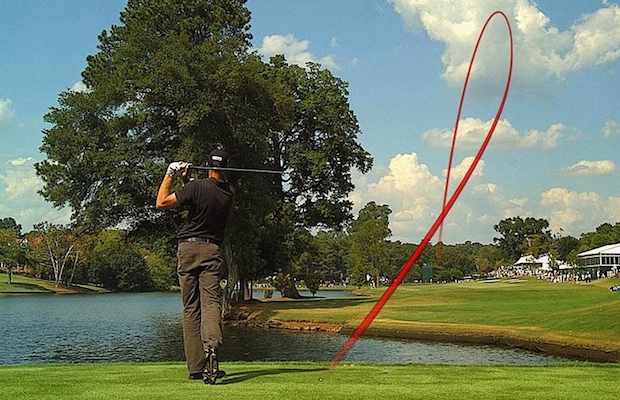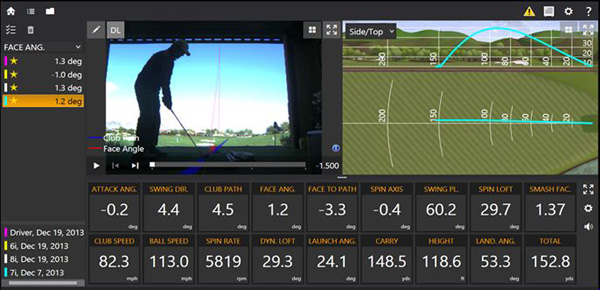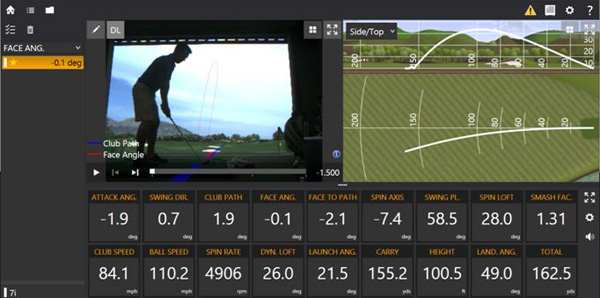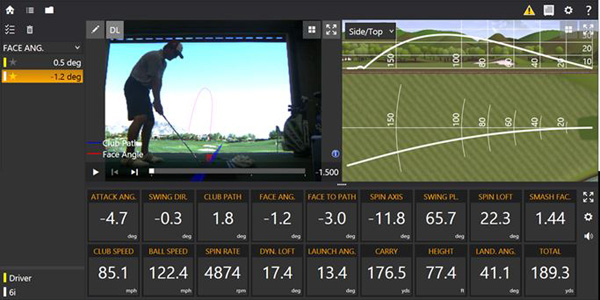Instruction
By the numbers: How to hit a draw

Doppler radar launch monitors have proved at least two things about ball flight.
- The golf club’s face angle at impact controls the ball’s starting direction.
- The club’s path influences the ball’s curvature.
Simply put, this means that ball flight will begin in the direction that the face is pointing at impact and curve away from the path of the club.
So, in order for a right-handed golfer to move the ball from right to left — the goal of most golfers — the face angle at impact must be between the path of the club and the target line. I have shown you what this look like at impact in a previous article “The Technique you Need to Hit a Proper Draw,” but today I’d like to add in the Trackman data to show you how important the face-to-path relationship really is.
Below is the classic push-draw swing where the path is right of the target and the face angle is slightly left of the path. This causes the ball to begin to the right of your target before curving back to the pin.
As you can see above, the path is moving from inside to outside at 4.5 degrees. The face at impact is 1.2 degrees right of the target, but 3.3 degrees left of the path. Now, examine the ball flight motion in the upper left screen. This shot starts out to the right and curves back to the target because of the relationship I just described above. In the true draw, you impact the ball with an open (not closed) club face as I will explain below.
One common mistake I see in amateurs trying to hit draws is the over-closing of the face at impact. That causes the ball to begin too much in-line with the target before curving to the left. In the Trackman screenshot below, you can see that the path is 1.9 degrees in-to-out, however, the clubface at impact is pointing at the target — 0.1 degree. That’s basically “0,” which means the face is pointed almost directly at the target. Now look at the top left ball flight screen; this ball started around the target-line and curved away from it, missing too far to the left.
The final swing pattern I see on the lesson tee with students trying to hit a draw is that they have the club face left of the target at impact. This causes the dreaded pull draw. As you can see below, the path is moving from inside to outside at 1.8 degrees. The face at impact is 1.2 degrees left of the target. That’s why this ball started left of the target and moved farther left. Golfers should know that this is a face issue, NOT a path issue! The key to curing this is not to swing more from in to out. If so, the ball would start even farther left!
Remember, in order to hit a push draw you need an in-to-out path and a face angle at impact that is pointing left of the path at impact, yet still right of the target so the ball will start right of the target before curving back on line.
I hope that you now see and understand how a draw is created and what you can do to control it on a consistent basis!
Instruction
The Wedge Guy: Beating the yips into submission

There may be no more painful affliction in golf than the “yips” – those uncontrollable and maddening little nervous twitches that prevent you from making a decent stroke on short putts. If you’ve never had them, consider yourself very fortunate (or possibly just very young). But I can assure you that when your most treacherous and feared golf shot is not the 195 yard approach over water with a quartering headwind…not the extra tight fairway with water left and sand right…not the soft bunker shot to a downhill pin with water on the other side…No, when your most feared shot is the remaining 2- 4-foot putt after hitting a great approach, recovery or lag putt, it makes the game almost painful.
And I’ve been fighting the yips (again) for a while now. It’s a recurring nightmare that has haunted me most of my adult life. I even had the yips when I was in my 20s, but I’ve beat them into submission off and on most of my adult life. But just recently, that nasty virus came to life once again. My lag putting has been very good, but when I get over one of those “you should make this” length putts, the entire nervous system seems to go haywire. I make great practice strokes, and then the most pitiful short-stroke or jab at the ball you can imagine. Sheesh.
But I’m a traditionalist, and do not look toward the long putter, belly putter, cross-hand, claw or other variation as the solution. My approach is to beat those damn yips into submission some other way. Here’s what I’m doing that is working pretty well, and I offer it to all of you who might have a similar affliction on the greens.
When you are over a short putt, forget the practice strokes…you want your natural eye-hand coordination to be unhindered by mechanics. Address your putt and take a good look at the hole, and back to the putter to ensure good alignment. Lighten your right hand grip on the putter and make sure that only the fingertips are in contact with the grip, to prevent you from getting to tight.
Then, take a long, long look at the hole to fill your entire mind and senses with the target. When you bring your head/eyes back to the ball, try to make a smooth, immediate move right into your backstroke — not even a second pause — and then let your hands and putter track right back together right back to where you were looking — the HOLE! Seeing the putter make contact with the ball, preferably even the forward edge of the ball – the side near the hole.
For me, this is working, but I am asking all of you to chime in with your own “home remedies” for the most aggravating and senseless of all golf maladies. It never hurts to have more to fall back on!
Instruction
Looking for a good golf instructor? Use this checklist

Over the last couple of decades, golf has become much more science-based. We measure swing speed, smash factor, angle of attack, strokes gained, and many other metrics that can really help golfers improve. But I often wonder if the advancement of golf’s “hard” sciences comes at the expense of the “soft” sciences.
Take, for example, golf instruction. Good golf instruction requires understanding swing mechanics and ball flight. But let’s take that as a given for PGA instructors. The other factors that make an instructor effective can be evaluated by social science, rather than launch monitors.
If you are a recreational golfer looking for a golf instructor, here are my top three points to consider.
1. Cultural mindset
What is “cultural mindset? To social scientists, it means whether a culture of genius or a culture of learning exists. In a golf instruction context, that may mean whether the teacher communicates a message that golf ability is something innate (you either have it or you don’t), or whether golf ability is something that can be learned. You want the latter!
It may sound obvious to suggest that you find a golf instructor who thinks you can improve, but my research suggests that it isn’t a given. In a large sample study of golf instructors, I found that when it came to recreational golfers, there was a wide range of belief systems. Some instructors strongly believed recreational golfers could improve through lessons. while others strongly believed they could not. And those beliefs manifested in the instructor’s feedback given to a student and the culture created for players.
2. Coping and self-modeling can beat role-modeling
Swing analysis technology is often preloaded with swings of PGA and LPGA Tour players. The swings of elite players are intended to be used for comparative purposes with golfers taking lessons. What social science tells us is that for novice and non-expert golfers, comparing swings to tour professionals can have the opposite effect of that intended. If you fit into the novice or non-expert category of golfer, you will learn more and be more motivated to change if you see yourself making a ‘better’ swing (self-modeling) or seeing your swing compared to a similar other (a coping model). Stay away from instructors who want to compare your swing with that of a tour player.
3. Learning theory basics
It is not a sexy selling point, but learning is a process, and that process is incremental – particularly for recreational adult players. Social science helps us understand this element of golf instruction. A good instructor will take learning slowly. He or she will give you just about enough information that challenges you, but is still manageable. The artful instructor will take time to decide what that one or two learning points are before jumping in to make full-scale swing changes. If the instructor moves too fast, you will probably leave the lesson with an arm’s length of swing thoughts and not really know which to focus on.
As an instructor, I develop a priority list of changes I want to make in a player’s technique. We then patiently and gradually work through that list. Beware of instructors who give you more than you can chew.
So if you are in the market for golf instruction, I encourage you to look beyond the X’s and O’s to find the right match!
Instruction
What Lottie Woad’s stunning debut win teaches every golfer

Most pros take months, even years, to win their first tournament. Lottie Woad needed exactly four days.
The 21-year-old from Surrey shot 21-under 267 at Dundonald Links to win the ISPS Handa Women’s Scottish Open by three shots — in her very first event as a professional. She’s only the third player in LPGA history to accomplish this feat, joining Rose Zhang (2023) and Beverly Hanson (1951).
But here’s what caught my attention as a coach: Woad didn’t win through miraculous putting or bombing 300-yard drives. She won through relentless precision and unshakeable composure. After watching her performance unfold, I’m convinced every golfer — from weekend warriors to scratch players — can steal pages from her playbook.
Precision Beats Power (And It’s Not Even Close)
Forget the driving contests. Woad proved that finding greens matters more than finding distance.
What Woad did:
• Hit it straight, hit it solid, give yourself chances
• Aimed for the fat parts of greens instead of chasing pins
• Let her putting do the talking after hitting safe targets
• As she said, “Everyone was chasing me today, and managed to maintain the lead and played really nicely down the stretch and hit a lot of good shots”
Why most golfers mess this up:
• They see a pin tucked behind a bunker and grab one more club to “go right at it”
• Distance becomes more important than accuracy
• They try to be heroic instead of smart
ACTION ITEM: For your next 10 rounds, aim for the center of every green regardless of pin position. Track your greens in regulation and watch your scores drop before your swing changes.
The Putter That Stayed Cool Under Fire
Woad started the final round two shots clear and immediately applied pressure with birdies at the 2nd and 3rd holes. When South Korea’s Hyo Joo Kim mounted a charge and reached 20-under with a birdie at the 14th, Woad didn’t panic.
How she responded to pressure:
• Fired back with consecutive birdies at the 13th and 14th
• Watched Kim stumble with back-to-back bogeys
• Capped it with her fifth birdie of the day at the par-5 18th
• Stayed patient when others pressed, pressed when others cracked
What amateurs do wrong:
• Get conservative when they should be aggressive
• Try to force magic when steady play would win
• Panic when someone else makes a move
ACTION ITEM: Practice your 3-6 foot putts for 15 minutes after every range session. Woad’s putting wasn’t spectacular—it was reliable. Make the putts you should make.
Course Management 101: Play Your Game, Not the Course’s Game
Woad admitted she couldn’t see many scoreboards during the final round, but it didn’t matter. She stuck to her game plan regardless of what others were doing.
Her mental approach:
• Focused on her process, not the competition
• Drew on past pressure situations (Augusta National Women’s Amateur win)
• As she said, “That was the biggest tournament I played in at the time and was kind of my big win. So definitely felt the pressure of it more there, and I felt like all those experiences helped me with this”
Her physical execution:
• 270-yard drives (nothing flashy)
• Methodical iron play
• Steady putting
• Everything effective, nothing spectacular
ACTION ITEM: Create a yardage book for your home course. Know your distances to every pin, every hazard, every landing area. Stick to your plan no matter what your playing partners are doing.
Mental Toughness Isn’t Born, It’s Built
The most impressive part of Woad’s win? She genuinely didn’t expect it: “I definitely wasn’t expecting to win my first event as a pro, but I knew I was playing well, and I was hoping to contend.”
Her winning mindset:
• Didn’t put winning pressure on herself
• Focused on playing well and contending
• Made winning a byproduct of a good process
• Built confidence through recent experiences:
- Won the Women’s Irish Open as an amateur
- Missed a playoff by one shot at the Evian Championship
- Each experience prepared her for the next
What this means for you:
• Stop trying to shoot career rounds every time you tee up
• Focus on executing your pre-shot routine
• Commit to every shot
• Stay present in the moment
ACTION ITEM: Before each round, set process goals instead of score goals. Example: “I will take three practice swings before every shot” or “I will pick a specific target for every shot.” Let your score be the result, not the focus.
The Real Lesson
Woad collected $300,000 for her first professional victory, but the real prize was proving that fundamentals still work at golf’s highest level. She didn’t reinvent the game — she simply executed the basics better than everyone else that week.
The fundamentals that won:
• Hit more fairways
• Find more greens
• Make the putts you should make
• Stay patient under pressure
That’s something every golfer can do, regardless of handicap. Lottie Woad just showed us it’s still the winning formula.
FINAL ACTION ITEM: Pick one of the four action items above and commit to it for the next month. Master one fundamental before moving to the next. That’s how champions are built.
PGA Professional Brendon Elliott is an award-winning coach and golf writer. You can check out his writing work and learn more about him by visiting BEAGOLFER.golf and OneMoreRollGolf.com. Also, check out “The Starter” on RG.org each Monday.
Editor’s note: Brendon shares his nearly 30 years of experience in the game with GolfWRX readers through his ongoing tip series. He looks forward to providing valuable insights and advice to help golfers improve their game. Stay tuned for more Tips!













Josh
Dec 21, 2014 at 6:21 pm
Click Here!
Z- man
Apr 23, 2025 at 12:55 pm
Great discussion. The one thing that I would add is the VAST MAJORITY of amateurs are coming over the top with a very steep out to in path. This is very hard to fix. Nevertheless, it needs to fixed first and foremost. Then club face can be addressed. Good luck.
CD
Oct 16, 2014 at 3:52 pm
One thing no-one talks about is how path can control face which determines direction, nor that the feel of a draw is a closing face. Let me explain!
If I say, suck the club inside, and my brain squares the club face to the now inside arc, I’m going to hit a push. And people will spend all day thinking ‘the face is open, better close it/square it. Then they get in a hell of a mess.
Every time I mention this someone says ‘that’s the old ball flight laws’. It’s not! I’m saying the face determines direction, just that the path determines face, for some players. I happen to believe this happens for many, many players. So perhaps the key is to get the path sorted first?
I’d be interested to know what you think Tom. Another key thing I see people fouling up is they try and have an open face through the ball to hit the ‘new’ ‘push draw’ and having already established an in to out arc they end up having it open to the arc or square to the arc. I think it is definitely a feeling of the face being inside or closed or closing to the arc. I think that needs to be paramount before the player tries to establish that closed club face to be open to the target. After all, again, no-one says why, despite being ‘wrong’ the ‘old ball flight’ laws did work most of the time (until you say, set the face at a tree you were trying to bend it round!) or at least were believed to work most of the time and seemed to do so too – the key principle in both being a divergence between face and path – closed for a draw and open for a fade and that the face is easier (or more sensitive to inputs) to control, and the path (or perhaps, outer boundary of the ball-flight) easier to establish with the swing or players aim.
CD
Oct 16, 2014 at 3:56 pm
Hence my old instructor’s ‘send it out there with the path (to the right), bring it back with the face’ never failed.
Tom Stickney
Oct 19, 2014 at 2:56 pm
Not quite sure what you mean. Sorry.
Mike
Oct 13, 2014 at 2:23 pm
Tom,
The face and path angles you show are pretty small angles. If you have someone swinging 4°-8° out, but the face relationship is not closed enough (2°-4° closed to target, right?) and hitting big pushes would you say that is a path, face or both problem? In other words, at what point is path the big issue and not the face?
No secret, that “someone” is me….
Jim_0068
Oct 13, 2014 at 2:51 pm
Couple things: One thing this article didn’t take into account was angle of attack (unless i missed it, i did read it twice), the more you hit down the more true path gets pushed to the right or in/out. For simplicity, imagine a driver..if you swing in/out 4 degrees and your face is open 2 degrees at impact and you hit down 2 degrees, you aren’t 2 closed closed you are 4 degrees closed as generally with a driver every 1* up/down will change the path 1* (down more right and up more left) so 4* in/out + 2* down = 6* true path in/out. Also with a player like yourself, who i’m going to assume is a decent player, you would usually fix your path (or AOA which you didn’t list) and leave the face alone. That much in/out will create very large push-draws (if you opened your face more) and you’d have trouble getting long irons in the air as your are delofting it so much.
Jafar
Oct 13, 2014 at 4:42 pm
you should write an article.
Jim_0068
Oct 13, 2014 at 5:37 pm
Thanks for the compliment, however everything tom wrote is 100% accruate and i agree with and the tendencies of the players he describes. I would have liked to see the angle of attack taken into account as well.
Tom Stickney
Oct 14, 2014 at 12:13 pm
Jim– did an earlier article on swing direction and aoa. Might check it out.
Thomas Beckett
Oct 14, 2014 at 1:23 am
I just wanted to add that a 1 to 1 relationship only applies if the club is delivered on a 45 degree angle. Great article Tom and nice post Jim_0068. Breaking down DPlane into practical numbers is tough to explain well.
Tom Stickney
Oct 14, 2014 at 12:13 pm
Correct
Tom Stickney
Oct 14, 2014 at 12:12 pm
Jim-
When talking about irons it isn’t a 1/1 ratio so aoa isn’t as big of a factor but it’s still very important. Sometimes on the lesson tee you have to do both. Wish it was cut and dry but it’s not. Lastly when a face is opened usually that adds loft not deducts loft as you stated. Thx.
Jim_0068
Oct 14, 2014 at 3:53 pm
Tom
I know that which is why I just used driver as an example since in general it’s about a 1/1.
Tom Stickney
Oct 14, 2014 at 12:06 pm
With that in to out path it could be gear effect from heel hits causing the pushes
Tom Stickney
Oct 14, 2014 at 12:08 pm
Mike– your comment posted below… Heel hits causing pushes?
Mike
Oct 15, 2014 at 9:52 am
No heel hits causing the blocks (talking irons here for most part), just face not closed to path.
I was wondering with a path that sometimes gets to that 8* mark if you as an instructor would work to match the face and hit bigger draws or would you work on path to get it more neutral?
My well struck shots are not big sweeping hooks so I do have a very hard time presenting the face at an acceptable angle when the path gets way in to out. In other words, when I start swinging 8* out I’m probably blocking it.
Thanks for the hard work on the articles. I always enjoy reading them.
Mike
Oct 15, 2014 at 9:53 am
2*-4* closed to PATH! Oops….
Tom Stickney
Oct 15, 2014 at 7:17 pm
Mike. If it was 8 in to out I’d make it a touch less.
Will
Oct 13, 2014 at 12:21 pm
Is there a good drill to practice keep the face angle slightly more open at impact?
Jim_0068
Oct 13, 2014 at 2:53 pm
As long as you’re a righty, bend your left wrist more in the backswing; feel like your left thumb is more “under” the club at the tope. This will help you open the face more (if that is what you need).
Jeremy
Oct 13, 2014 at 7:03 pm
I’m hardly a great authority, but I’ve found that weakening my grip helps a little.
Tom Stickney
Oct 14, 2014 at 12:17 pm
Be careful with wrist angle and grip changes. Big big alterations for sometimes a small issue. Start with small fixes before the tough ones.
Tom Stickney
Oct 14, 2014 at 12:14 pm
Will– set a stick in line with your target. Hit draws around the stick